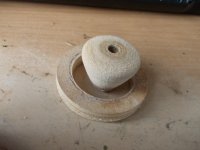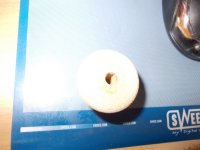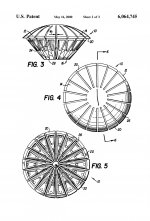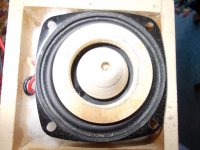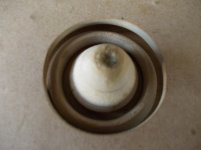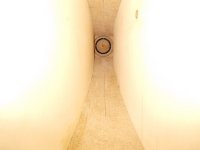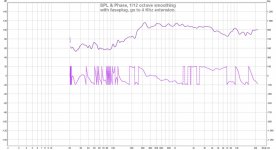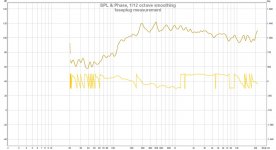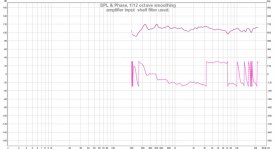That lathe looks great for 100e. As long as the motor is good should last for years and allow you to spin some large wood. Well done
That lathe looks great for 100e. As long as the motor is good should last for years and allow you to spin some large wood. Well done
I thought that the motor has a burned winding but motors are not a problem here, a lot in the old iron bussiness vrom big to small..
But there are more lathes, I have tryed with a normal drilling machine but that do not work well.
regards
Looks great mate...
Be careful as your wood gets bigger and heavier. Try to centre the wood and bolt the lathe to a secure bench. If it flips it will take half your shed out.
Have fun.
Be careful as your wood gets bigger and heavier. Try to centre the wood and bolt the lathe to a secure bench. If it flips it will take half your shed out.
Have fun.
Looks great mate...
Be careful as your wood gets bigger and heavier. Try to centre the wood and bolt the lathe to a secure bench. If it flips it will take half your shed out.
Have fun.
Not a problem, my head is already to big.
I now it has to be secured and also rule with machines is take care of the safety, use a face mask of professional quality.
The lath is already secured, and the support for the chisel is on the machine itselfs, so it flip not easely, and I do afcourse small things, but maybe I get the hang of it and make bigger horn, but never bass, the keeps square.
regards
Nice work Kees. Can you please provide a sketch of the phase plug dimensions/plan? Maybe we can try to copy what you have done? I have a 3d printer that might make quick work of it.
Nice work Kees. Can you please provide a sketch of the phase plug dimensions/plan? Maybe we can try to copy what you have done? I have a 3d printer that might make quick work of it.
You now I have to do it on speculation, I have no faseplug calculato
r software as I did see http://www.speakerlab.it/PPS.htm have one.
I use compression factor on eye en test it so I will let now dimensions afterwards.
regards
kees
I have now done the plugs and go start measuring this week. I am curious about the extension of the hf, the less it needs correction the better in words of distortion.
Plugs are not perfect, need a better machine and some skils, but The wooden horn was also the first time I did such wood work, tools are needed..
regards
Plugs are not perfect, need a better machine and some skils, but The wooden horn was also the first time I did such wood work, tools are needed..
regards
Attachments
Nice work there - looks very professional. I am amazed how small the cross sectional area of the actual "throat" is through the phase plug. Are you saying it doesn't need the high pass cap?
Nice work there - looks very professional. I am amazed how small the cross sectional area of the actual "throat" is through the phase plug. Are you saying it doesn't need the high pass cap?
I do not yet now how it will do in HF, have to measure, but have strange things with windows 10, like when download a recorded video from sony mobile phone it go take a movie elwhere from a harddisk , crazy windozs.
sound do wel without a cap, I go upload that later and put it here.
I do not now what is left over from crosssectional area, I did gamble here difficult to measure, maybe hornresp need a faseplug calculator or someone who can write that.
did measurement it exyens now to 4 khz before fall off, was first 1.5 Khz. so need really smaller path and I go so try a radial plug. First I go try also a filter this time a shelf for amp because fall off is different.
Measurement is without filter or shelf, but straight from amplifier output.
regards
Measurement is without filter or shelf, but straight from amplifier output.
regards
Attachments
some sound on youtube, not the best place and recording is what to loud for mobile phone.
But I have nothing better, except maybe my own mike;-)
https://youtu.be/60nVS-KVjaQ
But I have nothing better, except maybe my own mike;-)
https://youtu.be/60nVS-KVjaQ
Sounds really nice - clear and low distortion. Is it loud like I think it is?
Yes it is quite loud, correction for a good graph needs now les power and so lower distortion, that was my goal and still is, so now I try a radial plug..
Shelffilter used and measured, it need half less correction as before faseplug, so it is worth furter examination, but making faseplugs by hand is a art, timeconsuming but fun.
Dips can be resonances of the wooden horn, I go damp that stuff. maybe backchamber need more stuffing or cone breakup problems.
Dips can be resonances of the wooden horn, I go damp that stuff. maybe backchamber need more stuffing or cone breakup problems.
Attachments
Nice work. Adding soft damping like latex caulking on horn wall and another sheet of wood makes a big difference in frequency response smoothness and lower HD.
Things are progressing nicely! It seems the polarity is wrong again though, and the scale is way too large (~400 dB). Set it to something like 80-130 dB and the frequency-axis to 200 Hz - 22 kHz.Shelffilter used and measured, it need half less correction as before faseplug, so it is worth furter examination, but making faseplugs by hand is a art, timeconsuming but fun.
Dips can be resonances of the wooden horn, I go damp that stuff. maybe backchamber need more stuffing or cone breakup problems.
I'm guessing you could use some gating to get clearer measurements as the interesting frequencies are above 200 Hz. A 4 ms window is easily achievable even indoors, just keep speaker and microphone more than 1.2 m from all surfaces and use the "IR Windows" button in REW to set a window that is 1 ms before and 4 ms after.
/Anton
- Home
- Loudspeakers
- Multi-Way
- Presenting the Trynergy - a full range tractrix synergy.
